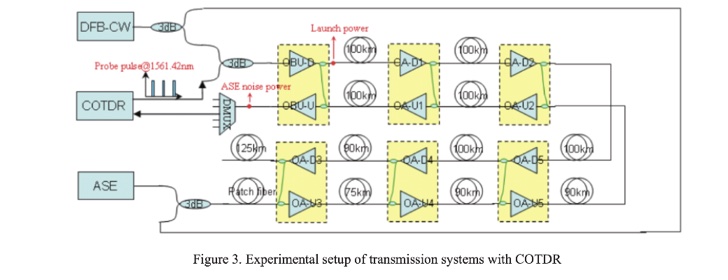

Coherent OTDRs: An OTDR to Test A Transoceanic CableThe world is now connected with over 400 transoceanic cables carrying unimaginable amounts of data. The world depends on these cables for communications, so testing and, in case of a problem, troubleshooting them quickly.On land, we use OTDRs, but we have access to most cables at many locations where drops are connected. But a transoceanic cable may have only access at each end of a cable thousands of km long, complicated by a number of repeaters consisting of fiber amplifiers. That creates two problems for using OTDRs, first the long distances involved and secondly the fact that fiber amplifiers are unidirectional - they cannot pass the backscatter signal the OTDR used to create traces and analyze the fiber. A reader of this newsletter gave us the clue to understand the solution to this problem by asking us "What is a C-OTDR?" A C-OTDR is a coherent OTDR. If you remember we explained coherent transmission here in the Newsletter before and created a page on coherent transmission systems in the FOA Guide. A coherent OTDR uses the same tech as a coherent link, with a transmitter that uses an external modulator to create pulses and a local oscillator in the receiver to increase dynamic range. In the OTDR, the local oscillator is simpler to provide, just tap the test source transmitter laser, since the transmitter and receiver are in the same instrument. But how do you overcome the problem of blocking of the backscatter signal by the inline optical amplifiers? Take a look at this diagram from Anritsu, the manifacturer of a C-OTDR.  Note two things - the OTDR does not have one port like a regular OTDR, it has two - transmit and receive. Secondly, the test is made with two fibers which normally transmit in opposite directions. The test signal is transmitted through and amplified by each fiber amplifier. But the output of the amplifier is split and a fraction of the signal is sent to the fiber transmitting in the opposite direction to return the test signal to the OTDR. The trace created is a series of link test for each span between the amplifiers. A technical paper by Huawei engineers on coherent OTDRs shows a slightly different approach.  The Huawei solution couples the signal out of the fiber amplifier to the input of the fiber amplifier next to it, amplifying the return signal. It appears that both approaches work. The OTDR traces essentially show a series of traces for each link in a row, allowing the tech doing the testing to characterize the links when installed and to pinpoint problems when necessary. |
|
FOA Guide Table of Contents
(C)2023, The Fiber Optic
Association, Inc. |